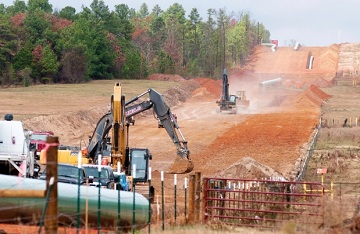$15B Enbridge pipeline network aims to move one million barrels of oil to market
 While Alberta worries about the huge gap between Canadian and U.S. oil prices caused by pipeline bottlenecks, Enbridge is working on a series of projects that aim to move more than one million barrels per day to markets.
While Alberta worries about the huge gap between Canadian and U.S. oil prices caused by pipeline bottlenecks, Enbridge is working on a series of projects that aim to move more than one million barrels per day to markets.The combination of line expansions and new construction represents more capacity than TransCanada’s 830,000 bpd Keystone XL pipeline that has dominated the news for over a year as it faced opposition and delays in the U.S.
Lines such as Enbridge’s Flanagan, Seaway and Sandpiper in the U.S. and the Eastern Access project in Canada have avoided the limelight, but are just as important in the effort to move oil from Alberta, Montana and North Dakota to markets on the U.S. Gulf Coast and the eastern seaboard.
“Enbridge recognized the importance of these market access issues quite some time ago, and we’ve been responding aggressively,” Enbridge chief executive Al Monaco said in Edmonton this week. “Over the next three years we’re investing $15 billion in three initiatives that can provide additional markets for about one million barrels of Alberta production. And that is in addition to all the regional pipeline development we’re undertaking in the oilsands and elsewhere.”
The biggest new crude highway will be the Gulf Coast Access, a $6.4 billion initiative that is already in partial operation. It involves an expansion of the Enbridge Mainline System to the Chicago area, then the construction of the Flanagan South line connecting that oil with the hub in Cushing, Oklahoma.
Construction of the 600,000 bpd Flanagan South is expected to begin this summer and be open the following year. It follows the existing, and much smaller, right of way used by the Spearhead pipeline. From Cushing, the existing Seaway Pipeline to Houston has been reversed and began carrying 400,000 bpd in January.
By the middle of 2014, a new parallel line with a link to Port Arthur, Texas will be in operation carrying an additional 450,000 bpd to the refineries on the coast.
A second initiative, the $6.2 billion Light Oil Market Access project, will feature the new 375,000 bpd Sandpiper line bringing oil from North Dakota and southern Saskatchewan down to the Chicago area, where several other expansions and additional links will tie-in lines and allow oil to flow south or east.
The third initiative, the $2.7 billion Eastern Access project, will include line upgrades to the current line to Sarnia — including replacement of much of the infamous Line 6B which leaked in Michigan in 2010.
By 2014, Enbridge expects to have 300,000 bpd moving east from Sarnia through a reversed Line 9 to refineries in the Toronto area and Montreal, replacing current imports from the North Sea, West Africa and the Middle East which arrive via a pipeline from Portland, Maine.
“Providing Ontario and Quebec refineries with access to light Canadian crude (through line 9) will enhance their competitive position,” said Monaco.
Quebec obtains 90 per cent of its crude for its two refineries from offshore sources, he added.
Line 9 currently has a capacity of 240,000 bpd, but Enbridge intends to add a polymer compound — called a Drag Reducing Agent — to the oil to allow it to flow with less friction and without increasing pressure in the line.
While Enbridge has no plans to expand its pipeline beyond Montreal, a pipeline to Quebec City and then down to the deepwater port of Saint John, N.B., would likely be the goal under a proposal by TransCanada to convert one of its natural gas lines from Alberta that feed the Montreal area to a crude oil line.
You can return to the main Market News page, or press the Back button on your browser.

